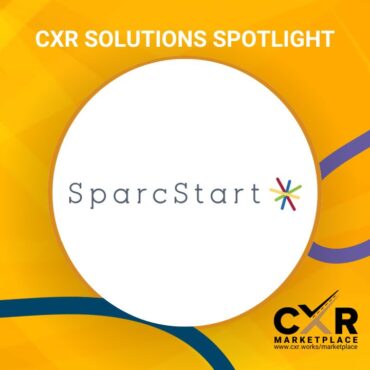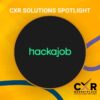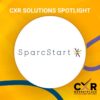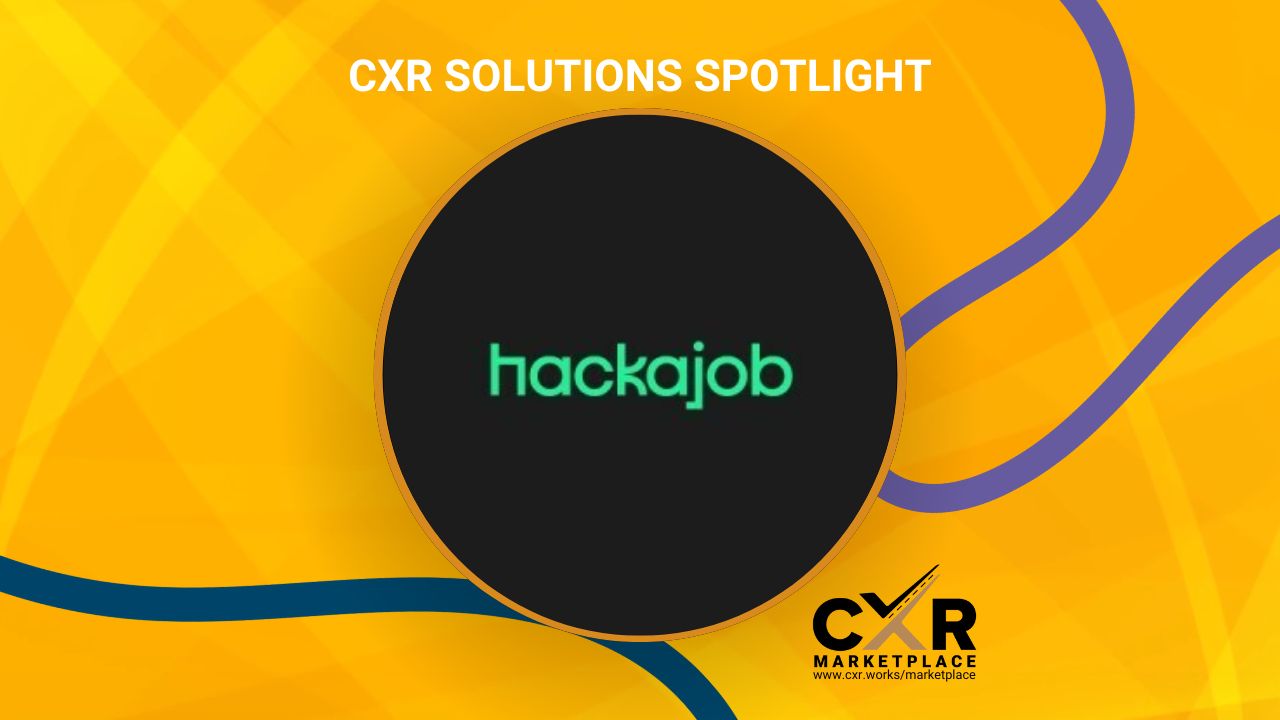
Solutions Spotlight on SparcStart
How do AI, image rights, and compliance collide in employer branding? Maury Hanigan breaks down the risks—and solutions—for TA leaders navigating new legal territory.
 play_arrow
play_arrow
Solutions Spotlight on Hackajob Cami Grace
 play_arrow
play_arrow
A Headhunter Changed Everything: Rob Daugherty’s Career Crossroads Cami Grace
 play_arrow
play_arrow
Solutions Spotlight on SparcStart Cami Grace
 play_arrow
play_arrow
From Operations to Coaching: Lori Chartrand’s Career Crossroads Cami Grace

Featured Guests:
Sam Berthoud, Hackajob
Hosts:
Chris Hoyt, President, CareerXroads
Episode Overview:
In this episode of CXR Spotlight, Chris Hoyt sits down with Sam Berthoud of Hackajob to explore the latest advancements in recruitment technology. Sam introduces three AI-powered agents—Chase, Thena, and Archer—designed to improve job intake, candidate screening, and proactive sourcing. With insights drawn from over a decade of verified hiring data, Hackajob is redefining how talent teams engage with both job requirements and candidate pools.
Key Topics:
Role calibration and intake with Chase
Candidate screening and enrichment through Thena
Passive candidate engagement via Archer
Leveraging first-party hiring data for accuracy and relevance
Integration with ATS systems like Greenhouse
Output-based pricing model for AI recruitment tools
Enhancing recruiter efficiency and candidate experience
Use of real-time salary benchmarking and contextual skill matching
Notable Quotes:
“Only one in 33 candidates gets invited to interview with a recruiter.” – Sam Berthoud
“Chase helps with role intake calibration… everything that comes after only matters if you get that right.” – Sam Berthoud
“Thena can go ask and verify if a candidate’s profile is missing info.” – Sam Berthoud
“Archer identifies candidates who meet the prerequisites and invites them to apply.” – Sam Berthoud
Takeaways:
Hackajob’s three AI agents—Chase, Thena, and Archer—offer a streamlined, data-driven approach to modern recruitment. From better understanding role requirements to surfacing only relevant, verified candidates, these tools aim to relieve pressure on lean TA teams and improve hiring outcomes. Each agent is designed to plug into existing workflows and adapt to specific organizational needs.
Want more conversations like this?
Subscribe to the CXR podcast and explore how top talent leaders are shaping the future of recruiting. Learn more about the CareerXroads community at cxr.works.
Chris Hoyt: For those who are just dialing in, or maybe you’re catching this on the recording—very cool. We do these every once in a while. These are what we call CXR Spotlights. Nobody pays to be on these, but we do them with folks who are doing really cool work. We also do this with our CXR members.
We have some solution members, like Hackajob, who’ve been with us for a couple of years now. They’re just leaning in and doing cool stuff that we think deserves a spotlight. I try to keep it pretty simple.
Sam, before we jump in, want to give us the escalator pitch? Like, who is Sam, what do you do at Hackajob, and maybe set the stage for what we’re going to see today? Because it’s pretty slick.
Sam Berthoud: Lovely to be back. I think I was on about two years ago—just before we released Hackajob Intelligence. Since then, we’ve been on a bit of a journey and definitely have some exciting things to show today.
My role—kind of grandiose—is basically just to speak to customers and speak on stage. I spend a lot of time between products, between customers, across all different stages of the customer lifecycle.
Prior to this, I was Managing Director of a recruitment events company. I built things like Fest and RO 100, so I spent 10 years listening to people far more intelligent than myself—mainly talent acquisition directors—talking about their challenges. I’ve seen cycles of different technologies come and go.
We’re at a pivotal moment right now, and I think we’ve built something pretty special. I’d love to share it today. I kind of feel the pressure’s on because our CEO just did a session that ended as this one started—so we’ll see who did a better job!
Also, I’ve got a cold—that’s my excuse. But no, we’re game. It’s game on.
Chris Hoyt: You’re gonna be great. What I love is you’ve got the luck of the Fallout bobblehead behind you. That Fallout 76 bobble—you can’t go wrong.
Sam Berthoud: That’s it. My luck’s up to 15. Nerds everywhere, unite.
Chris Hoyt: They’re in good company with us.
Sam Berthoud: Exactly.
Chris Hoyt: Want to set the stage before we do a screen share?
Sam Berthoud: Sure. Hackajob has been operating for the past decade, always really thoughtful about creating different solutions to industry challenges. Right now, I think we have an opportunity to solve some of the biggest problems that have pre-existed AI and have only been amplified by AI’s advancement.
I’m going to talk through a triplet—three different agents that help along that process. We’re going to try and cover it in 40 minutes. Wishful thinking, but we’ll aim for a nice overview.
Chris Hoyt: That’s right, and I’m here to ask all the silly questions, poke a bit. If anybody’s live with us—we’re streaming on LinkedIn—there should be a chat. If you’ve got questions for Sam, pop them in the chat. We’ll try to get to them. If we miss any, Sam and I will follow up in the thread.
So Sam, are you ready?
Sam Berthoud: Let’s do it. We’ve got 41 minutes to make this happen.
We’re going to talk through three different agents today. Underlying all of them is our matching technology. We’re fortunate to have gathered 50 million unique data points on hiring processes over the past decade. That lets us ensure relevance. And while it’s an AI-native platform, we’re not building this for the first time—it’s built on a foundation of deep hiring process knowledge for enterprises.
One big area that’s just broken is the data foundation in most tools today. On one side, you’ve got the job description. Ask yourself—does your job description accurately reflect what the hiring manager wants? Probably not. On the other side, you’ve got the CV. We’re trying to match two bits of data that don’t speak the same language.
So a lot of what we do is around calibration and truly understanding what’s required for a position. Right now, only one in 33 candidates gets invited to interview with a recruiter. You need nearly 4x the applications to make a hire. Meanwhile, TA teams are leaner and having to process more applications, with increasing irrelevance and fraud.
Hiring is changing faster than the systems. That’s where our agents come in. We’ll do live demos of each. But first, know that all our data is first-party, validated with individuals. So you have confidence and trust in what you see—and you get high-quality candidate responses.
Let’s start with the first agent: Chase.
Chase helps with role intake calibration. As folks like Jerry and Bill have said, recruitment has two core tenets: 1) understand what the hiring manager actually wants, and 2) everything that comes after only matters if you get that right.
Let’s go to the live demo…
[Sam demonstrates Chase and the job intake process.]
Chris Hoyt: What I love is you said, “I don’t have time for this, just get the job out,” and Chase was like, “Totally understand, but I’ve got a few more questions for you.”
Sam Berthoud: Yeah, and you want that safe level of pushback. That was a short demo—I didn’t give enough info. Chase was nudging me to give more.
Chris Hoyt: I’m curious—how is Chase educated on what’s important to the org or the function to know what to probe for?
Sam Berthoud: Great question. We’ve got a rich ecosystem. Chase can do real-time salary benchmarking, because a hire is made every 50 minutes on Hackajob. He knows what skills command what salaries in which locations.
It’s all contextual. For example, when you’re hiring a Java engineer, it’s not just about the keyword—it’s about how that skill is used in context. Chase understands that because we’ve spent a decade collecting hiring data.
Chris Hoyt: Is the AI pulling only from within Hackajob’s ecosystem for skills and salary?
Sam Berthoud: For salary—yes, all within Hackajob. We capture salary from every candidate and every role. For contextual skills, we’re using multiple data sources but it’s all rooted in our foundation of verified hiring data.
Chris Hoyt: Love it. OK, that’s agent #1.
Sam Berthoud: Now onto agent #2: Thena.
Thena addresses what I think is the single biggest challenge in recruitment right now—too many applications, with too few being relevant. And recruiters don’t have the time or tools to process them properly. This leads to poor candidate experiences and burnout for TA teams.
Thena sits post-application, helping you match and rank candidates using our deep contextual and preference-based matching.
Let me show you how that works within Greenhouse, our own ATS.
[Sam demonstrates filtering in Greenhouse using Thena.]
Thena gives you control. Based on the calibration done with Chase, you can quickly see which candidates meet the must-have and nice-to-have skills.
You can toggle filters, adjust for preferences like location or salary, and even ask Thena to go gather more info from candidates if something’s unclear.
Chris Hoyt: So you’re saying Thena is reading the resume, screening question responses, and enriching profiles to determine match?
Sam Berthoud: Exactly. And if a candidate’s profile is missing info, Thena can go ask and verify.
Chris Hoyt: And is Thena learning across the org—like what hiring managers or recruiters consistently want?
Sam Berthoud: Yes, that’s the beauty of our platform. We gather feedback and structured data on why candidates decline or get declined. That helps refine everything—from recruiter performance to candidate sentiment, pass-through rates, and more.
Chris Hoyt: Great. So, what about agent #3?
Sam Berthoud: Agent #3 is Archer.
Archer is all about proactively driving relevant passive candidates to apply. It’s not about adding to the noise—it’s about increasing the signal.
Unlike traditional job ads where anyone can apply, Archer identifies candidates who meet the prerequisites and invites them to apply. These are often people who don’t know your company but would be a great fit.
We match on everything—skills, salary, location, preferences—and only bring in verified, qualified candidates. Archer is our most adopted agent right now and can be live within 24 hours.
Chris Hoyt: And this marketplace—how big is it?
Sam Berthoud: Right now, we have about 1.4 million verified candidate profiles you can source from. Every profile is first-party—we don’t scrape or use third-party data.
Chris Hoyt: Are profiles enriched?
Sam Berthoud: Yes. For example, if someone has deployed something using AWS SageMaker, we know they must have experience with ML and cloud computing—even if it’s not listed explicitly. That’s the power of contextual matching.
Chris Hoyt: Wow. And how are you charging for all this?
Sam Berthoud: It’s output-based. You only pay for qualified candidates, not impressions. Each agent is also available à la carte, depending on your needs.
Chris Hoyt: Love that. I know you’re going to be at Breakfast next week—can folks demo this there?
Sam Berthoud: Absolutely. Come say hi, bring your hardest-to-fill role, and we’ll show you how the agents work.
Chris Hoyt: Sam, thank you so much for your time. We’ll drop this video on your CXR Marketplace profile at cxr.org/marketplace. Folks, check it out—and if you’re at Breakfast, stop by, grab a drink, and meet Chase. Until next time, take care!
Tagged as: Talent Acquisition, Greenhouse, Hackajob, Technology, Podcast, Solutions Spotlight.

How do AI, image rights, and compliance collide in employer branding? Maury Hanigan breaks down the risks—and solutions—for TA leaders navigating new legal territory.
